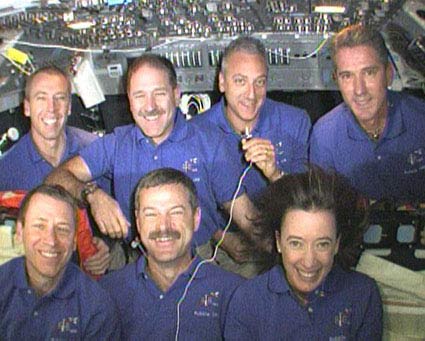Shuttle Atlantis in Good Shape for Friday Landing

HOUSTON - Thevital heat shield on the space shuttle Atlantis received a clean bill of healthWednesday as its astronaut crew prepares to return home after successfullyoverhauling the Hubble Space Telescope.
Missionmanagers said Atlantis in fine shape for its planned Friday, though rainyweather could delay the spacecraft?s return. Mission Control asked the shuttle?sseven-astronautcrew to power down some non-essential systems in order to extend their stayin orbit, if required.
?It?s afairly benign power down and it?s fairly non-intrusive,? said LeRoy Cain, NASA?sdeputy shuttle program manager, in a news briefing here at the Johnson SpaceCenter.
OnWednesday, the astronauts took a well-deservedday off and discussed their mission with reporters and the crew of theInternational Space Station. They also took a personal phone call from U.S.President Barack Obama.
Cain toldreporters that the power conservation measures require shutting down backupcomputers and other non-vital systems, but shouldn?t impact life aboardAtlantis. It will extend the shuttle?s supplies enough to allow it to stayaloft through Monday, though NASA hopes to land Atlantis Friday at 10:01 a.m.EDT (1401 GMT) at the Kennedy Space Center in Cape Canaveral, Fla.
Led by veterancommander Scott Altman, the Atlantis astronauts are wrapping up an 11-daymission to the Hubble Space Telescope to give the beloved 19-year-oldobservatory onelast service call. The astronauts added two new instruments, performedvital maintenance and fixed a pair of broken instruments that were neverdesigned to be repaired in space.
The exhaustingwork, all packed within an intense five-spacewalk marathon, left Hubble morepowerful than ever before and should extend the long-lived observatory?slife for at least five or 10 years.
Breaking space news, the latest updates on rocket launches, skywatching events and more!
Theastronauts also primed the telescope for its eventual death. They added adocking ring that will allow a robotic vehicle to latch onto Hubble sometimeafter 2020 and send the space telescope plunging into the Pacific Ocean whenits mission ends.
To reach Hubble?s350-mile (563-km) orbit, Atlantis had to fly in a region known to have morespace junk than NASA?s typical flight to the 220-mile (354-km) highInternational Space Station. NASA had a backup shuttle ? Endeavour ? on standbyto fly a rescue mission just in case Atlantis suffered irreparable damage. Butthe shuttle weathered the flight superbly, Cain said.
?Themission has been a great success so far,? Cain said. ?It was everything weanticipated and even more.?
SPACE.comis providing continuous coverage of NASA's last mission to the Hubble SpaceTelescope with senior editor Tariq Malik in Houston and reporter ClaraMoskowitz in New York. Clickhere for mission updates and SPACE.com's live NASA TV video feed.
- New Video - In Their Own Words: The Last Hubble Huggers
- New Video Show - Hubble's Final Shuttle Service Call
- Image Gallery - Hubble?s Latest Views of the Universe: Part 1, Part 2

Tariq is the award-winning Editor-in-Chief of Space.com and joined the team in 2001. He covers human spaceflight, as well as skywatching and entertainment. He became Space.com's Editor-in-Chief in 2019. Before joining Space.com, Tariq was a staff reporter for The Los Angeles Times covering education and city beats in La Habra, Fullerton and Huntington Beach. He's a recipient of the 2022 Harry Kolcum Award for excellence in space reporting and the 2025 Space Pioneer Award from the National Space Society. He is an Eagle Scout and Space Camp alum with journalism degrees from the USC and NYU. You can find Tariq at Space.com and as the co-host to the This Week In Space podcast on the TWiT network. To see his latest project, you can follow Tariq on Twitter @tariqjmalik.
